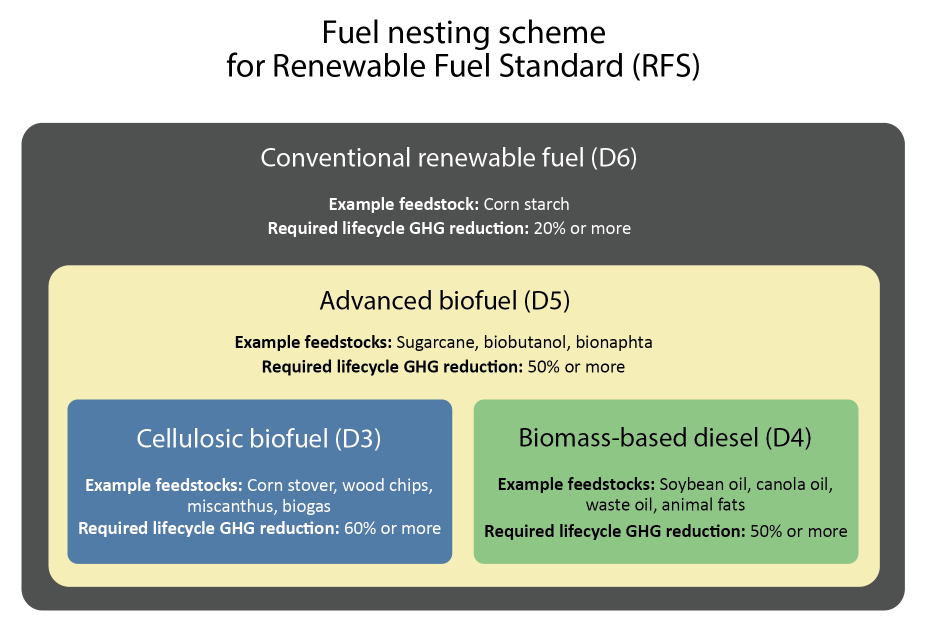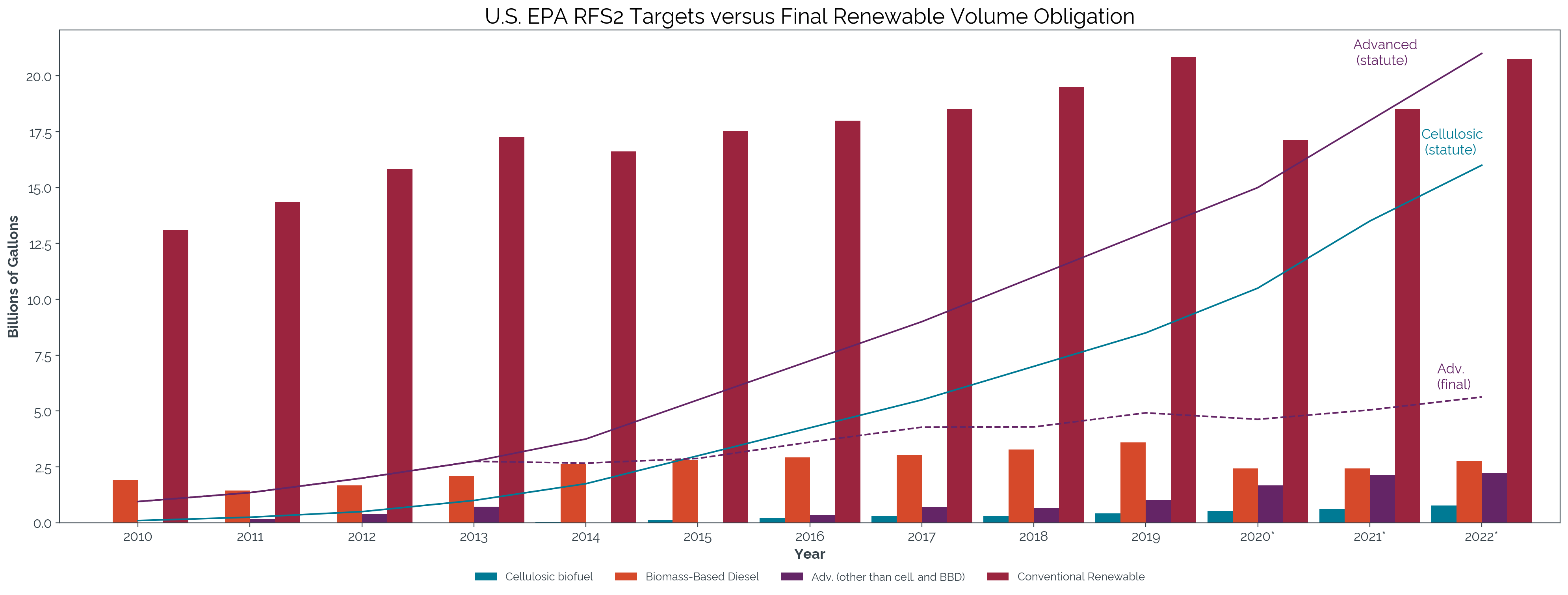Overview
The Renewable Fuel Standard (RFS2) places requirements for the minimum annual supply of three categories of biofuels, including corn ethanol, cellulosic biofuel, and advanced biofuel. These requirements are updated annually.
Renewable fuel standard
Regulating Body
U.S. Environmental Protection Agency (EPA)
Celluslosic biofuels, bio-massed based diesels, and other advanced biofuels
History
The first Renewable Fuel Standard (RFS1) was created under the Energy Policy Act of 2005 and included small targets for blending ethanol in gasoline. On February 3, 2010, the United States Environmental Protection Agency (EPA) released substantial revisions to the National Renewable Fuel Standard. The new rule (RFS2), which incorporates changes mandated by the 2007 Energy Independence and Security Act (EISA), is a significant amendment to the original RFS1 standard. RFS2 regulates renewable fuels (biofuels) in the entire US. It relies on life cycle analysis (LCA) as a tool to regulate fuels, incorporating greenhouse gas (GHG) emissions from indirect land use change (ILUC) in its LCA framework.
At the state level, other regional fuel policies complement the federal RFS. After California introduced its Low Carbon Fuel Standard (LCFS) in 2009, several other states started to propose and adopt their standards. Oregon successfully implemented its LCFS program in 2016, while Washington signed its standard into law in 2021, which will take effect in 2023. Both programs are modeled after LCFS and are part of a joint effort with California– the Pacific Coast Collaborative (PCC) –a partnership designed to encourage low carbon fuels at the regional level. Various Northeastern and Mid-Atlantic States, led by Massachusetts and some Midwestern states, have also considered adopting regional programs. Massachusetts intends to do so by 2026.
Biofuel production in the U.S. is also supported through various tax credits.
RFS Standards
RFS2 represents a hybrid approach that superimposes a performance-based eligibility framework on a set of volumetric targets. In contrast to RFS1, which was limited to gasoline substitutes, the 2nd iteration expands the RFS program to cover gasoline and diesel intended for use in highway and non road vehicles and engines. RFS2 classifies renewable fuels according to four nonexclusive categories, based on GHG-reduction thresholds and feedstock types, and sets volumetric requirements for each. The categories are:
- Renewable fuels – minimum 20% GHG reduction
- Advanced biofuels – minimum 50% GHG reduction, and cannot be produced from corn starch
- Biomass-based diesel – minimum 50% GHG reduction
- Cellulosic biofuel – minimum 60% GHG reduction, must be produced from cellulosic feedstocks.
Cellulosic biofuel and biomass-based diesel are exclusive, but each fulfills the requirements for Advanced and Renewable Fuels (). Cellulosic diesel may qualify for either cellulosic or biomass-based diesel RINs. The required volumes for each category increase over time (see figure). The RFS2 rule set volumes for biomass-based diesel through 2012 only, with a requirement of 1 billion gallons that year; in subsequent years, EPA has established a volume mandate at or greater than 1 billion gallons. The volume requirements for 2022 are shown in the table below:
| Fuel | Actual Volume | Ethanol Equivalent Volume* | Percentage Standard |
|---|---|---|---|
| Cellulosic biofuel | 362 mil gal | 630 mil gal | 0.35% |
| Biomass-based diesel | 1.84 bil gal | 2.76 bil gal | 2.33% |
| Advanced biofuel | 7.7 bil gal | 5.63 bil gal | 3.16% |
| Renewable fuel | 20.63 bil gal | 20.63 bil gal | 11.59% |
| *Biodiesel and cellulosic diesel have equivalence values of 1.5 and 1.7 ethanol equivalent gallons respectively. As a result, ethanol-equivalent volumes are larger than actual volumes for cellulosic biofuel and biomass-based diesel. | |||

On June 3, 2022, EPA finalized a package of actions setting biofuel volumes for the RFS program for the years 2020, 2021, and 2022, seen in the table below, and introduced regulatory changes intended to enhance the program’s objectives. EPA also established a 250-million-gallon “supplemental obligation” in the finalized volumes for 2022 and stated its intent to add another 250 million gallons in 2023, addressing the 2014-2016 annual rule by the DC Circuit Court of Appeals in Americans for Clean Energy v. EPA. The court ruled that the PA may not consider the volume of renewable fuel available to ultimate consumers or the demand-side constraints that affect consumers’ use of renewable fuel when assessing whether the domestic supply is “inadequate.”
| Fuel | 2020 | 2021 | 2022 |
|---|---|---|---|
| Cellulosic Biofuel | 0.51 | 0.56 | 0.63 |
| Biomass-Based Diesel | 2.43** | 2.43** | 2.76 |
| Advanced Biofuel*** | 4.63 | 5.05 | 5.63 |
| Total Renewable Fuel | 17.13 | 18.84 | 20.63 |
| Supplemental Standard | n/a | n/a | 0.25 |
| *All values are ethanol-equivalent on an energy consult basis, except for biomass-based diesel (BBD), which is biodiesel-equivalent. **The 2020 and 2021 BBD volumes were established in previous RFS annual rule makings. ***The Advanced Biofuels volume comprises Cellulosic Biofuel, Biomass-Based Diesel volumes, and any other liquid fuels derived from non-food-based feedstocks that yield a lifecycle reduction in greenhouse gas emissions of at least 50% compared with fossil fuels. |
|||
The divergence of Final Volume Standards from the initial statutory requirements under RFS2 has only grown since 2013. As discussed above, the adjustments reflect limited domestic availability across the four regulatory categories. Annual statutory requirements for renewable fuels and final standards from 2010-2022 are illustrated in the figure below. In 2022, final volume requirements for cellulosic biofuel were more than 96% lower than statutory requirements; technology did not progress as fast as hoped at the time of the initial rule making. Required total advanced biofuels (a category including cellulosic and bio-mass-based diesel) were 73% lower than the statutory requirements for that year.

RFS2 only establishes renewable volume obligations through 2022, and there is uncertainty surrounding the Biden administration’s plan to implement the program. As of June 2022, 2023, renewable volume obligations have not yet been released.
Technical information on biofuel specifications can be found at US: Fuels: Biodiesel specification.
RIN Trading System
For every gallon of biofuel created, the producer earns one Renewable Identification Number (RIN) specific to the biofuel category (e.g., Renewable RIN, Cellulosic RIN). RINs are awarded based on energy content; for instance, one gallon of biodiesel earns 1.5 RINs because it has a higher energy density. The RIN remains attached to the biofuel, and once the biofuel is blended into road fuel, the RIN can be sold or traded.
When the RFS2 was finalized, there was no commercial production of cellulosic biofuel, so the regulation stipulates that in years when projected production of cellulosic biofuel falls short of that year’s target, EPA should issue a revised target to match availability. EPA must issue cellulosic waiver credits equivalent to the revised volume mandate. Obligated parties (fuel blenders and suppliers) may fulfill their revised obligation for cellulosic biofuel with either cellulosic RINs or waiver credits. The cellulosic requirement has been revised downward for every year of the RFS2. In 2012, EPA revised the original condition of 500 million gallons to 10.5 million gallons and thus issued 10.5 million cellulosic waiver credits. Actual production that year was 20,069 gallons, falling short of the revised target.
Assessment of Greenhouse Gas Reductions
To assess the GHG reduction of specific biofuel pathways, EPA uses an economic model to evaluate the marginal increase in emissions in a scenario where a given volume of biofuel is supplied compared to one in which a lower volume of biofuel is provided. This modeling accounts for systemwide changes throughout the global agricultural sector. For example, if corn is used for renewable fuel in the U.S., this may raise the international price of corn and result in cropland expansion to produce more corn in other countries. This effect is called “indirect land use change” (iLUC). RFS is the first national regulation adopted anywhere in the world that recognizes the potential for significant contributions to lifecycle GHG emissions from ILUC. (At the state level, California has already incorporated ILUC GHG emissions in carbon-intensity calculations under its LCFS.)
A biofuel pathway must exceed a GHG reduction threshold to qualify under a particular category in the RFS. Renewable fuels (e.g., corn ethanol) must reduce GHG emissions by at least 20% compared to gasoline or diesel. Advanced fuels (e.g., Brazilian sugarcane), including biomass-based diesel (e.g., soy biodiesel), must reduce GHG emissions by at least 50%. Cellulosic fuels (e.g., corn stover ethanol) must reduce emissions by at least 60%.
Links
Regulatory documents
US Renewable Fuel Standard (RFS)
US Renewable Fuel Standard II (RFS2)
California Low Carbon Fuel Standard
Additional Resources
Final Volume Standards for 2020, 2021, 2022
Summary Report on Low Carbon Fuel-Related Standards – ICCT October 2009
Potential Biomass-Based Diesel Production in the United States by 2032 – ICCT Working Paper February 2020
U.S. Biofuels Policy: Let’s Not be Fit for Failure – ICCT Blog Post October 2021

